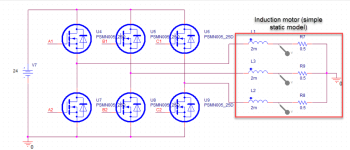Punx0r said:Remember that phase current can be 2-3 times battery current...
How does current get doubled-tripled?
Punx0r said:Remember that phase current can be 2-3 times battery current...
Comrade said:Punx0r said:Remember that phase current can be 2-3 times battery current...
How does current get doubled-tripled?
E-HP said:
- A motor's speed is the result of the voltage provided by the (PWM) controller, which is lower than 50V at anything less than full throttle.
- If the controller is providing the motor less than 50V, say 20V for example, but the motor is consuming 1000W, then the current being provided to the motor would be 1000W/20V or 50A.
Comrade said:Are you sure the controller has the ability to control voltage? I thought it's just a bunch of MOSFETs that PWM the output of the battery, nothing more, nothing less.
So if the battery is able to deliver 20A, the phase wires will never see more than 20A. There is no any kind of step down or step up circuitry in the controller. Arguably the phase wires can even be thinner than battery wires, in the context of heating up, since any one of the 3 phase wires is only at 66% duty cycle.
Comrade said:Are you sure the controller has the ability to control voltage? I thought it's just a bunch of MOSFETs that PWM the output of the battery, nothing more, nothing less.
No, because the changing voltage on the motor's inductance creates a changing current which can be much higher than the current out of the battery (becuase the voltage is less, and the power is "the same" (not counting losses), the current is more).So if the battery is able to deliver 20A, the phase wires will never see more than 20A.
The controller and motor together *are* a conversion (step-up/down) circuit. That is specifically how PWM motor controllers work (for both brushless and brushed motors).There is no any kind of step down or step up circuitry in the controller.
amberwolf said:These are all things that people new to this stuff find hard to accept, but are true. THere are numerous threads about these types of things if you wish to poke around the forum.
Comrade said:amberwolf said:These are all things that people new to this stuff find hard to accept, but are true. THere are numerous threads about these types of things if you wish to poke around the forum.
Thanks. I'm an engineer but not an electrical engineer, so the more complex concepts like electromagnetism are not easily deduced with just common sense. :lol:
I'll have to read up and maybe even test this on a bench, as I'm confused how low voltage and high current comes out of the motor back to the controller.
E-HP said:The physics explanation is something that falls under high school physics, which is why I chose to explain it that way.
Comrade said:E-HP said:The physics explanation is something that falls under high school physics, which is why I chose to explain it that way.
Electromagnetism in high school?
spinningmagnets said:The names "phase current" and "battery current" don't make sense to me
E-HP said:Perhaps the quality of a high school education has deteriorated over the last 45 years. Maybe the same holds true for engineering classes.

Comrade said:E-HP said:Perhaps the quality of a high school education has deteriorated over the last 45 years. Maybe the same holds true for engineering classes.
Perhaps. Do you mind pointing out on his diagram which wires will experience 2-3 times the amps when the motor is under heavy load?
1.png
Say the DC battery is able to provide 20A max. I'd like to understand where there will be 40-60A on any of the external wires.

